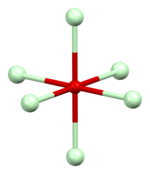Neodymium(III) oxide or neodymium sesquioxide is the chemical compound composed of neodymium and oxygen with the formula Nd2O3. It forms very light grayish-blue hexagonal crystals.[1] The rare-earth mixture didymium, previously believed to be an element, partially consists of neodymium(III) oxide.[2]
Uses
Neodymium(III) oxide is used to dope glass, including sunglasses, to make solid-state lasers, and to color glasses and enamels.[3] Neodymium-doped glass turns purple due to the absorbance of yellow and green light, and is used in welding goggles.[4] Some neodymium-doped glass is dichroic; that is, it changes color depending on the lighting. One kind of glass named for the mineral alexandrite appears blue in sunlight and red in artificial light.[5] About 7000 tonnes of neodymium(III) oxide are produced worldwide each year. Neodymium(III) oxide is also used as a polymerization catalyst.[4]
Reactions
Neodymium(III) oxide is formed when neodymium(III) nitride or neodymium(III) hydroxide is roasted in air.[6]
Structure
Neodymium(III) oxide has a low-temperature trigonal A form in space group P3m1.[7] This structure type is favoured by the early lanthanides.[8][9] At higher temperatures it adopts two other forms, the hexagonal H form in space group P63/mmc and the cubic X form in Im3m. The high-temperature forms exhibit crystallographic disorder.[10][11]
| Packing | Neodymium coordination | Oxygen O1 coordination | Oxygen O2 coordination |
|---|---|---|---|

|

|

|

|
| A-M2O3 structure type | approximately capped octahedral | octahedral | approximately tetrahedral |
References
- ^ a b c Lide, David R. (1998), Handbook of Chemistry and Physics (87 ed.), Boca Raton, FL: CRC Press, pp. 471, 552, ISBN 0-8493-0594-2
- ^ Brady, George Stuart; Clauser, Henry R.; Vaccari, John A. (2002), Materials Handbook (15 ed.), New York: McGraw-Hill Professional, p. 779, ISBN 978-0-07-136076-0, retrieved 2009-03-18
- ^ Eagleson, Mary (1994), Concise Encyclopedia of Chemistry, Springer, p. 680, ISBN 978-3-11-011451-5, retrieved 2009-03-18
- ^ a b Emsley, John (2003), Nature's Building Blocks, Oxford University Press, pp. 268–9, ISBN 978-0-19-850340-8, retrieved 2009-03-18
- ^ Bray, Charles (2001), Dictionary of Glass (2 ed.), University of Pennsylvania Press, p. 103, ISBN 978-0-8122-3619-4, retrieved 2009-03-18
- ^ Spencer, James Frederick (1919), The Metals of the Rare Earths, London: Longmans, Green, and Co, p. 115, retrieved 2009-03-18
- ^ D. Taylor (1984). "Thermal Expansion Data: III Sesquioxides, U2N3, with the corundum and the A-, B- and C-M2O3 structures". Trans. J. Br. Ceram. Soc. 83: 92–98.
- ^ Greenwood, Norman N.; Earnshaw, Alan (1997). Chemistry of the Elements (2nd ed.). Butterworth-Heinemann. p. 1238-1239. ISBN 978-0-08-037941-8.
- ^ A. F. Wells (1984). Structural Inorganic Chemistry (5th ed.). Oxford University Press. pp. 544–547.
- ^ Müller-Buschbaum, H. (1966). "Zur Struktur der A-Form der Sesquioxide der Seltenen Erden. II. Strukturuntersuchung an Nd2O3". Z. Anorg. Allg. Chem. 343 (1–2): 6–10. doi:10.1002/zaac.19663430103.
- ^ Aldebert, P.; Traverse, J. P. (1979). "Etude par diffraction neutronique des structures de haute temperature de La2O3 et Nd2O3". Mater. Res. Bull. 14 (3): 303–323. doi:10.1016/0025-5408(79)90095-3.


Recent Comments